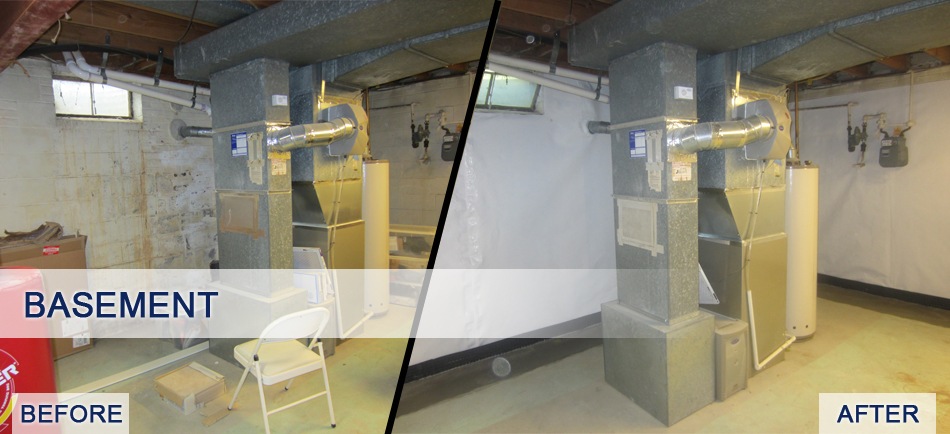Since it is spring, and the season of serious flooding in Northern Virginia, we want you to be prepared. Whether you’ve already had basement waterproofing services done or not, it’s important to make sure you regularly inspect your basement for weak spots that could lead to damage in case of a serious flood. So, if you live in Northern Virginia and the flood has already come, do you know how to clean it up? Whether you’re new to the area or have lived here for many years, it’s important to follow safety protocols when cleaning your home after a flood.
How Do I Start the Cleaning Process?
Floodwaters contain a lot of germs and debris from unknown locations, so you don’t want to risk getting injured just to clean up your home. Follow these steps below to ensure you stay safe while cleaning your flooded basement.
- Get Proper Gear – As stated earlier, you don’t know what could be lurking in the floodwaters in your home, so it’s important to be protected. Even if you’re not going to be wading in the water, it’s important to have waterproof footwear and gloves to ensure you are protected from any hidden sharp objects, bacteria, and chemicals that may be floating in your basement.
- Get the Water Out – If you have a sump pump, that is the best option to get water out as it is made for that purpose and professionally tested. However, if you don’t have that, you’ll want to get a pool pump, wet/dry vacuum, or a mop and bucket. You’ll want to get as much moisture out of the basement as possible before mold can start to form and damage your home’s structure.
- Shovel – If your basement has been flooded, it’s likely it has a lot of mud, dirt, and silt sitting underneath all that water. As soon as you get the water out, you’ll want to start shoveling the worst of the mud and silt before it dries and becomes more difficult to remove. Depending on how deep the water was, this part of the cleaning process may take some time. You will need to hose down the walls and floors, as well as rinse the area several times to ensure it is truly clean before disinfecting the surfaces.
- Clean & Disinfect – You’ll need a few different household cleaners and disinfectants to make sure that your home is truly clean after a flood. Powdered or liquid cleaners are best because they are less expensive than aerosol options and can easily be bought in bulk.
- Walls, woodwork, linoleum, tile, and other hard surfaces – Use household ammonia or trisodium phosphate to disinfect. Liquid dish soap, like Ajax, is also great to help remove any mud, silt, or grease that has made its way into your home
- Carpets & furniture – You can use diluted chlorine bleach to disinfect your carpets and other furniture, but depending on how long it’s been sitting in water, it may be safer and cleaner to throw it out altogether and buy new.
- Any textile fabrics – clothes, curtains, etc. – Regular laundry detergent typically works well on these, and if chlorine bleach is safe to use on the textiles, you can use that as a disinfectant. Lysol or pine oil are also great disinfectants if chlorine bleach is too destructive. If you have any special clothing items made of wool or silk, you will have to consult a professional dry cleaner for cleaning instructions.
- Be thorough – No matter how long water has been in your basement, it’s likely to cause some damage. During this cleaning process, when you’re making sure all items and surfaces are disinfected, it’s important to make sure that you set your home up for success. Once water makes its way into the home, you’re more likely to get mold growth. During cleanup, make sure you:
- Remove interior wall finishes & insulation – This lets the water out of the area. If you feel or see any moisture in these parts, they should be replaced.
- Scrub, Clean, & Disinfect Floors – If you want to avoid mildew growth, it’s best to scrub the floors with a stiff brush within 48 hours of the flooding. However, if you’re not able to do that, make sure you use hot water, detergent, and a disinfectant to really clean the floors. You will have to refinish your wood floors and replace any wood that has water stains. Heat helps get rid of mildew, as well as mildew-resistant paint, so keep that in mind during the remodeling process.
- Dry the Area Completely – It’s important to surface dry the area as quickly as possible, within 24-48 hours to reduce the potential for contamination or mold growth. If you continuously circulate hot air over the wet surfaces, turn your heat on, use dehumidifiers, or even use a combination of all three, you can significantly reduce drying times. However, depending on the home, it can take weeks to months before everything is completely dried out.
Call the Professionals
After you’ve been through this intense cleaning process, you’ll want to figure out how you can avoid doing it again. That’s what we’re here for. At Basement Masters Waterproofing, we’re dedicated to helping home and business owners with all their basement waterproofing needs. A sump pump can drastically improve your clean up time after a flood, not to mention our other interior and exterior waterproofing services that are guaranteed to help direct water away from your home instead of inside it. Ready to start your home project? Give us a call today for a free quote!
